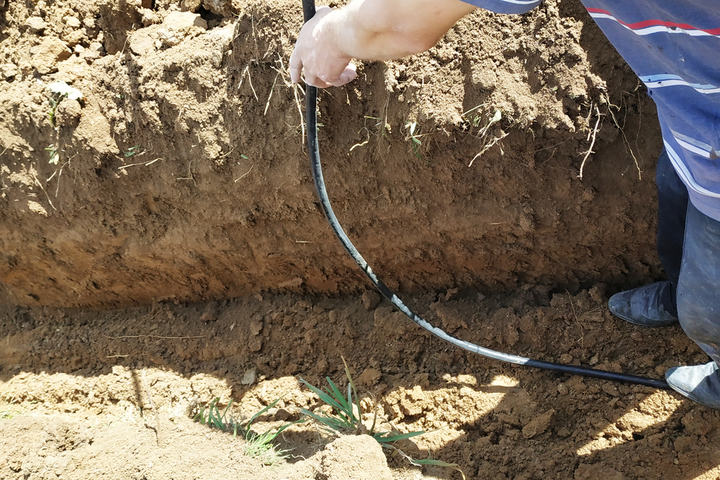No matter how big your planned landscape lighting installation will be, you’ll likely need to think carefully about how you’re going to wire it all together.
Even a small-to-mid-sized garden will need a long cable if you plan to have lights around the border.
You need to be sure that the wire you choose will work over those longer distances.
How long you can run landscape lighting wire depends mainly on the wire gauge, although the number of lights also has an impact. 14/2 wire is fine for small runs, but for longer runs, you’ll need 12/2 or 10/2 to avoid voltage drop.
To help you make your decision for your own installation, let’s take a look at:
- How far landscape lighting wiring can run
- Which gauge wire is best over long distances
- How far 14/2 low voltage wire can run
- How to calculate your landscape lighting wire needs
How Far Can Landscape Lighting Wiring Run?

Two main factors will determine how far you can run your outdoor wiring.
Wire Gauge
Wire gauge is the most important thing to consider. The gauge of the wire is the measurement of the wire’s diameter.
This directly impacts the maximum recommended Wattage it can cope with and how much voltage drop you can expect.
Voltage drop is the term used to describe the power lost across an electrical circuit.
Every part of a circuit – including the wire itself – has a resistance that will reduce the total voltage running down the line.
Thicker wire means less resistance, which means the drop in voltage over a set distance will be lower.
It also means that you can run the thicker wire over a longer distance without the voltage drop being a problem.
If you choose a wire gauge that isn’t suitable for a longer distance, any lights on the circuit will not get the voltage they need to run properly.
They might glow dimly or flicker. A miscalculation here means re-laying the entire wire to repair the issue.
Not fun!
Number Of Lights
The number of lights you have on a circuit will similarly impact how long you can run the cable.
If you’re running it for a long distance but only for two or three lights, the voltage drop might not be an issue but add more, and, likely, the length of wire can’t cope.
As long as you choose the right wire gauge for the distance you want and aren’t overloading the maximum recommended Wattage for that wire gauge, you shouldn’t have any problems.
Which Gauge Wire Can Be Run Furthest?

With the knowledge that thicker wire can run for longer, it’s good to understand what the range of landscape lighting wires tends to cover.
The AWG (American Wire Gauge) system covers wires from 0000 ratings, measuring almost a half-inch in diameter (11.7mm), right down to 26 rated wire, which measures 0.0159 inches or 0.4mm in diameter.
However, when you’re looking for landscape lighting wire, you’re likely going to see cables between 8 and 18, and they’ll step up by two – so 8, 10, 12, 14, 16, and 18.
It’s also worth noting that there’s a second number involved in wire gauges which explains how many conductors are used in the wire.
For landscape lighting, it’s almost always 2, so expect to see wire gauges of 8/2, 10/2, and so on.
Of those, 8/2 can be run the furthest. But it’s not a common choice in landscape lighting and is probably overkill for most home projects.
18/2 can run the least distance without voltage drop, as that is the thinnest of the common landscape lighting cables.
Most people tend to buy either 14/2 or 12/2 wire for landscape lighting for the best balance between cost, the flexibility of the cable, and the distance it can run without losing efficiency.
Bigger projects might call for 10/2 wire to be used.
How Far Can You Run 14/2 Low Voltage Wire?

With the 14/2 cable gauge being one of the more popular options for landscape garden lighting, how does it compare to other gauges, and what limitations do you have?
It will vary depending on the number of lights you’re using, but let’s work to a maximum. As an example, we’ll go for a 200 Watt transformer.
Now that doesn’t mean you can connect up to 200W of lights.
In theory, you can, but it’s recommended that you only ever add up to 80% of a transformer’s capacity to your system. This protects it if there are any fluctuations.
So with a 200W transformer, we can work with 160W of lights. Let’s explore how far you can run each of the cable gauges based on that power level.
Instantly, you can rule out 18/2 and 16/2 wire for this much power, because it exceeds their maximum wattage. But here’s a comparison for each gauge:
| Wire Gauge | Maximum Wattage | Distance the cable can run for 160W lights |
|---|---|---|
| 18/2 | 120W | N/A |
| 16/2 | 156W | N/A |
| 14/2 | 180W | 24 feet |
| 12/2 | 240W | 52 feet |
| 10/2 | 300W | 82 feet |
| 8/2 | 480W | 131 feet |
How To Calculate Landscape Lighting Wiring Requirements

That example above is great if you’re planning on using exactly 160 Watts of lighting. Still, if you aren’t, you’re going to want to work out how to calculate your requirements yourself.
Rather than working out how long you can run a wire, you can measure the distance you’ll be running the cable and then work out which wire you should be using.
To do this you need to know the wire constants. Landscape lighting wire is almost always made from copper, and for copper wire, the constants are:
| Wire Gauge | Constant |
|---|---|
| 18/2 | 1380 |
| 16/2 | 2200 |
| 14/2 | 3500 |
| 12/2 | 7500 |
| 10/2 | 11920 |
| 8/2 | 18960 |
Start by multiplying the total Wattage of the lights you want to use by the distance you’ll be laying the cable in your feet.
Divide this by the wire constant. It’s a good idea to start with 12/2, and then you can try 14/2 or 10/2; if you end up with the result, that’s no good.
Once you have the result, multiply it by two, and you’ll have the total voltage drop. Anything higher than 1.5 is no good. You’ll likely see problems with your lights.
Under 1.5V, and you’re fine. However, if it’s a lot lower than 1.5, you can try a thinner wire gauge to see if that would work.
If you only have 60 Watts of lights, and you’ve measured that, you’ll be using 50 feet of cable.
60 * 50 = 3000
Let’s try it with 12/2 wiring, so we divide 3000 by 7500 = 0.4.
Multiplied by 2, we get a 0.8 V drop, which is well within acceptable limits.
So let’s try with 14/2 wire:
3000/3500 = 0.85. Multiplied by 2 = 1.7
That’s higher than 1.5V, so the lights may not work properly. For 60W of lights over 50 feet, use 12/2 cable.
Also read: Why Do Landscape Lighting Flicker?
Final Words
Once you understand why a wire gauge is important and have the formula, it’s quite straightforward to work out which wire you should buy for your project.
Don’t assume you have to buy 8/2 wire since it will be more expensive and harder to work with.
Work out which is the optimal cable for you, giving yourself the wiggle room to upgrade your lights in the future if you think you might want to.
Already set up your landscape lights? Which wire gauge did you opt for?

